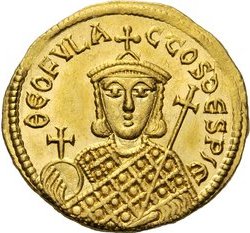Saint Michael Maleinos was a Byzantine monk who commanded great respect among Christians of Asia Minor. He was the brother of general Constantine Maleinos and uncle of Nikephoros Phokas, who was greatly influenced by Michael and became Byzantine emperor several years after Michael's death. His feast day is July 12.
The Excubitors were founded in c. 460 as the imperial guards of the early Byzantine emperors. Their commanders soon acquired great influence and provided a series of emperors in the 6th century. The Excubitors fade from the record in the late 7th century, but in the mid-8th century, they were reformed into one of the elite tagmatic units, the professional core of the middle Byzantine army. The Excubitors are last attested in the Battle of Dyrrhachium in 1081.
Prōtostratōr was a Byzantine court office, originating as the imperial stable master. Its proximity to the imperial person led to a highly visible role in imperial ceremonies, and served as a springboard for several capable individuals, like Manuel the Armenian or the future emperors Michael II and Basil I the Macedonian, to reach the highest offices. From the mid-11th century, the post rose in importance, becoming more an honorific dignity for senior members of the court, than an actual office. From the 13th century on, the post could be held by several persons, and ranked eighth in the overall hierarchy of the court. Throughout its history, it was a title often borne by senior military commanders. The female form of the title, given to the wives of the prōtostratores, was prōtostratorissa (πρωτοστρατόρισσα).
The 42 Martyrs of Amorium were a group of Byzantine senior officials taken prisoner by the Abbasid Caliphate in the Sack of Amorium in 838 and executed in 845, after refusing to convert to Islam. They are commemorated by the Eastern Orthodox Church on March 6.

Symbatios, variously also Sabbatios (Σαββάτιος) or Sambates (Σαμβάτης) in some sources, was the eldest son of the Byzantine emperor Leo V the Armenian. Soon after the coronation of his father, he was crowned co-emperor and renamed Constantine (Κωνσταντῖνος). He reigned nominally along with his father until the latter's deposition in 820, after which he was exiled to Prote, one of the Princes Islands, as a monk.
Theophilos Erotikos was a 10th-century Byzantine jurist and official.
The Droungarios of the Watch, sometimes anglicized as "Drungary of the Watch", was originally a senior Byzantine military post. Attested since the late 8th century, the droungarios commanded the Vigla or "Watch", one of the elite professional cavalry regiments (tagmata) of the middle Byzantine period, and was in charge of the Byzantine emperor's personal security. From c. 1030, the office was disassociated from its military origin and was transformed into a senior judicial position, thereafter usually referred to as the Grand Droungarios of the Watch. The office continued to exist as a mostly honorific court dignity in the Palaiologan era, until the very end of the Byzantine Empire in the mid-15th century.
Sisinnios Triphyllios was one of the senior dignitaries of the Roman Empire during the reign of Empress Irene of Athens (797–802) and her successor Emperor Nikephoros I (802–811).
Elpidius or Elpidios was a Byzantine aristocrat and governor of Sicily, who was accused of conspiring against Empress Irene of Athens. This forced him to rebel, and after being defeated he defected to the Abbasid Caliphate and was recognized there as Byzantine emperor.

Theophylact or Theophylaktos was the eldest son of the Byzantine emperor Michael I Rhangabe and grandson, on his mother's side, of Nikephoros I. He was junior co-emperor alongside his father for the duration of the latter's reign, and was tonsured, castrated, and exiled to Plate Island after his overthrow, under the monastic name Eustratius.
Eustathios Argyros was a Byzantine aristocrat and one of the most prominent generals under Emperor Leo VI the Wise. The first member of the Argyros family to rise to high posts, he fought with distinction against the Arabs in the east, before being disgraced ca. 907, possibly in connection with the flight of Andronikos Doukas to the Arabs. Rehabilitated soon after, he was appointed as strategos of Charsianon, from which post he oversaw the settlement of Armenian lords as march-wardens along the Empire's eastern frontier. Promoted to commander of the imperial bodyguard in late 908, he again fell into disgrace shortly after and died of poison on his way to his estates.
Eustathios [Argyros] was a Byzantine admiral under Emperor Leo VI the Wise.
Theoktistos was a senior Byzantine official who played an important role under the Nikephorian dynasty (802–813).

Theoktiste, also known as Phlorina (Φλώρινα), was the mother of the 9th-century Byzantine empress Theodora, the wife of Emperor Theophilos.
Adralestos was the Domestic of the Schools in the early years of Romanos I Lekapenos' reign.
The rhaiktōr was a high-ranking court position of the middle Byzantine Empire.
Chase, the son of Ioube, originally Hasan ibn Ayyub, was a senior Byzantine official of Arab origin.
Damian was a senior Byzantine eunuch official during the reign of Emperor Michael III, serving as the head chamberlain (parakoimomenos) to the emperor.
Saint Antony the Younger was a Byzantine military officer who became a monk and saint. He is commemorated by the Eastern Orthodox Church on 1 December.










